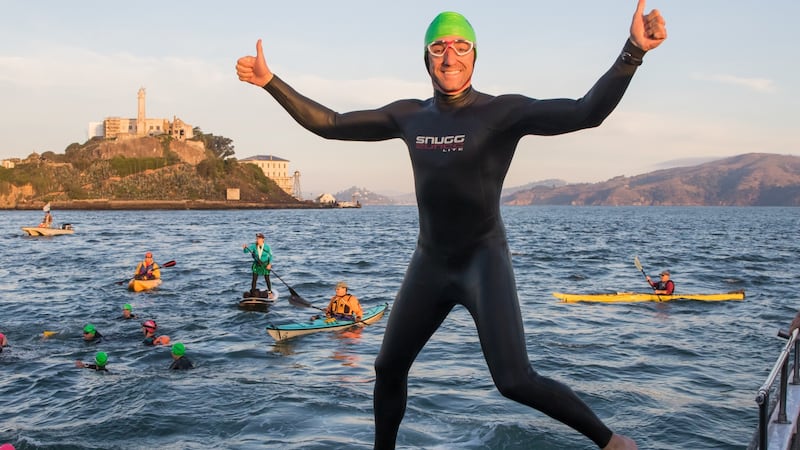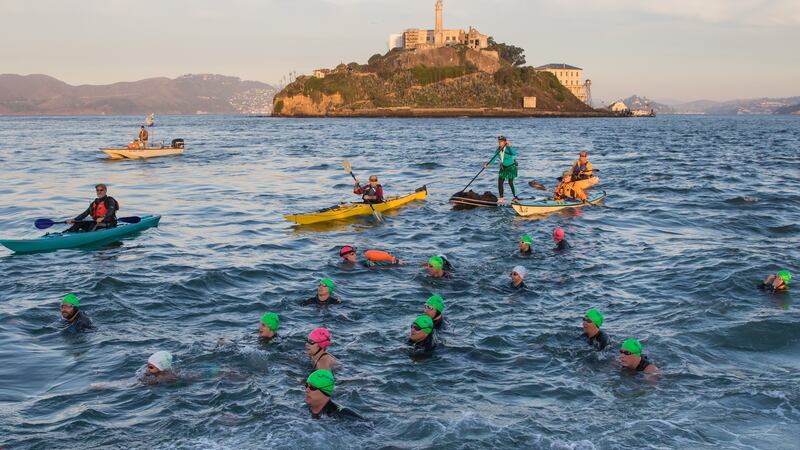In hindsight, visiting San Francisco’s aquarium the day before attempting to swim across the bay was a mistake. But I wasn’t to know they’d be displaying a YouTube video of a Great White Shark pulverising a sea lion just off the shore of Alcatraz Island– the very spot where I’d be diving in early the following morning. There are some things that you just can’t un-see.
Long before You Tube, the sharks of San Francisco Bay haunted the nightmares of men considering swimming from the island back to the city. Those men had plenty of time for nightmares. Most of them were locked up for 23 hours a day and tall tales of man-eating sharks were spread by Alcatraz prison guards to dissuade them from making a swim of it. Half a century after the prison was closed, a crossing that was only ever considered by caged desperados now attracts thousands of law-abiding free folk who pay $200 (€192) each for the privilege of swimming the 1½ miles from The Rock back into the city.
It is odd, but no more odd than our enduring fascination with Alcatraz itself. It was a prison for less than 30 years, was by most accounts a bastion of justice and humane treatment and hadn’t even a single execution to horrify us. And yet it is the world’s most infamous place of incarceration, and also now a bright flame to brainless moths like me who cannot resist an irrational adventure challenge.


It's partly Clint Eastwood's fault. His 1979 film Escape From Alcatraz presented his inconclusive conclusions on one of the island's enduring mysteries. It told the true story of three men: Frank Morris and brothers Clarence and John Anglin who made it clear of the prison in June 1962 and were never seen again. Nobody knows for sure whether they made good their escape or drowned in the attempt but most rational analysis focuses on the true dangers of the bay – the frigid water and omnipotent and capricious currents – rather than the irrational hype surrounding the sharks.
Although great whites do occasionally make their way into the bay in search of lunch and there is that gruesome video evidence to prove it, it's a rare occurrence as they don't like the much lower salt content in the water and prefer the deeper waters beyond the Golden Gate Bridge. But that is precisely where those who don't know the waters or can't handle the temperature end up, and the mythology of unassailable Alcatraz and the impossible swim is grounded in the disappearance or recapture of all those who tried it.
Inaccurate reconstruction
To help me decide whether or not Morris and the Anglins could have made it, I signed up with Water World Swim, a local company that runs escorted monthly crossings. It wasn't an altogether accurate reconstruction: I had the advantage of a wetsuit, weeks of training, a carb-loaded breakfast and a guide who knows how to swim the bay better than anyone.
Pedro Ordenes is the head coach and founder of Water World Swim and has swum from The Rock a remarkable 979 times.
“Alcatraz is a big draw because it’s very challenging, but it can be done,” he says. “Years ago people had the belief that it could not be possible to swim it and there was nobody to learn how the currents work. I started helping people when I moved here 26 years ago and it’s grown into more than I was expecting.”
I met Pedro and his team at half past six in the morning beside their boat in Fisherman's Wharf, ordinarily an area of San Francisco groaning under the weight of tourists and tourism traders but eerily still in the darkness of an early Saturday morning. Our briefing focused primarily on the swim route. It's about 1½ miles back into Aquatic Park, the swimmer-safe harbour and beach at the far end of Fisherman's Wharf, but it's the cold water and those infamous tides that provide the real challenge.
"We will be swimming at ebb tide," said Coach Mike. "So that means the currents are heading back out towards the Golden Gate Bridge and through to the ocean. We don't want anyone starting their holiday in Hawaii a few weeks early, so listen up."
We were advised to aim for the SS Jeremiah O’Brien, a former second World War ship and survivor of the D-Day landings. If we swam in that direction, Mike assured us, the current would pull us to the right and towards the narrow entrance of Aquatic Park.
We approached the island in the boat as the morning sun cloaked the prison in a welcoming orange glow. Five decades earlier, Morris and the Anglin brothers had launched a crude raft made of stitched-together raincoats in silence and darkness, but recreating their epic struggle for our own amusement, we would have the benefit of a beautiful clear morning and a flotilla of paddle boarders and dinghies at a ratio of one guide per swimmer.
Because I was insulated by my wetsuit, the water temperature was nowhere near as shocking as expected when I leapt from the side of the boat. After a brief check of my goggles and a brief contemplation of the absurdity of bobbing in the beautiful bay, I put my head down and headed for the city.
Fog and choppy seas had been forecast but neither materialised and every time I raised my head to breathe on each side I saw either the Golden Gate or Oakland Bay Bridges looming above the low swell. Beneath me, I could see nothing beyond my own arms. The tumultuous tide, as the Pacific Ocean forces itself in and out of a gap a mile wide, constantly churns sand and sediment, and visibility is never good.
Unexpected serenity
It was just as well. Great whites may be rare, but there are numerous leopard and sevengill sharks, both allegedly bottom feeders and scared of humans, but big enough to completely ruin the unexpected serenity I found in crossing San Francisco Bay at dawn.
Well, all was serene for the first half of the swim. The heavier tide closer to the city held the harbour on the horizon as each stroke needed an intensity of effort to inch us closer. Despite my best efforts to steer for the Jeremiah O’Brien, I felt rudderless as I was pulled to the right. It’s an unpredictable stretch of water, even for someone who has swum it 979 times.
“The bay is always different, every single day,” reflected Pedro when we finished. “You swim Alcatraz, it can be the best day of your life, or it can be the worst day. One of the things I believe is that people should learn, train and prepare diligently. It’s always going to be a challenge.”
I grazed the sand of Aquatic Park after 44 minutes and stood up, a little dizzy in the push and pull of the waves but happy and proud. I was grateful for both my own conditioning and the undeniable assistance of a wetsuit. Could it be done without either? Replenishing ourselves with Irish Coffees an hour later in the Buena Vista café – a San Francisco institution – thoughts turned to June 1962 and the events that have inspired films, books and swimmers ever since.
Pedro believes that Frank Morris, the brains behind the escape, made it across the bay to Sausalito, and is living somewhere in Central America. He had read books in the prison library on the currents and conditions of the Bay, and as Pedro said, “he had an idea where he would end up”.
“To make this crossing you have to be determined, you have to be mentally prepared. 50 percent mentally prepared, 50 percent working to make it out there. I believe this guy was prepared. The two others I think went down with hypothermia possibly, and headed out to sea but this guy . . . they found part of the raft, and I think from there he had some help in going somewhere.”
“It’s my own theory, I think one day this guy is gonna turn up and it will be the news of the year. That’s my fantasy- that some day I’m going to meet this guy.”
Part of the mental torture of Alcatraz for the prisoners was the fact that when the wind blew in the right direction, they could hear all the sounds of one of the most entertaining cities on the planet. The desire to rejoin the real world was all consuming, and in all probability it cost those three men their lives. For the rest of us, recreating their swim is far from life or death, but it’s certainly life affirming.
swim Alcatraz
Graham Little swam from Alcatraz with Water World Swim, the open water swimming specialists that organise monthly, supervised attempts, amongst other challenges and trips. waterworldswim.com
Get there
Graham flew to San Francisco with Aer Lingus, which operates a daily year-round service from Dublin to San Francisco from €299, aerlingus.com
Swim
Organisers Water World Swim are the open water swimming specialists that organise monthly, supervised Alcatraz attempts amongst other challenges and trips. waterworldswim.com
The Dardanelles Swim: Buccaneering poet Lord Byron made this swim famous when he managed to cross the 4.5 kms from European Turkey to Asian Turkey in 1810. The Dardanelles Strait splits the country and the continents. English company Swim Trek organises a crossing on August 30th each year.
Strait of Messina: The clear, azure waters of the Mediterranean have temperatures around the mid-20s in summer, so the 3.5kms crossing between Sicily and the Italian mainland can be comfortably attempted without a wetsuit. Water World Swim organises the event, which is piloted by the record holder, Giovanni Fiannacca. His time of 37 minutes, 35 seconds hasn’t been beaten since 1975.
Warrior Swim: The waters around County Sligo are neither azure nor warm, but the conditions are all part of the challenge. The 2017 Ocean FM Warrior of the Sea is on Saturday, August 5th and links two of the county’s most famous holiday villages, Rosses Point and Strandhill. warriorofthesea.wixsite.com/wots/info













